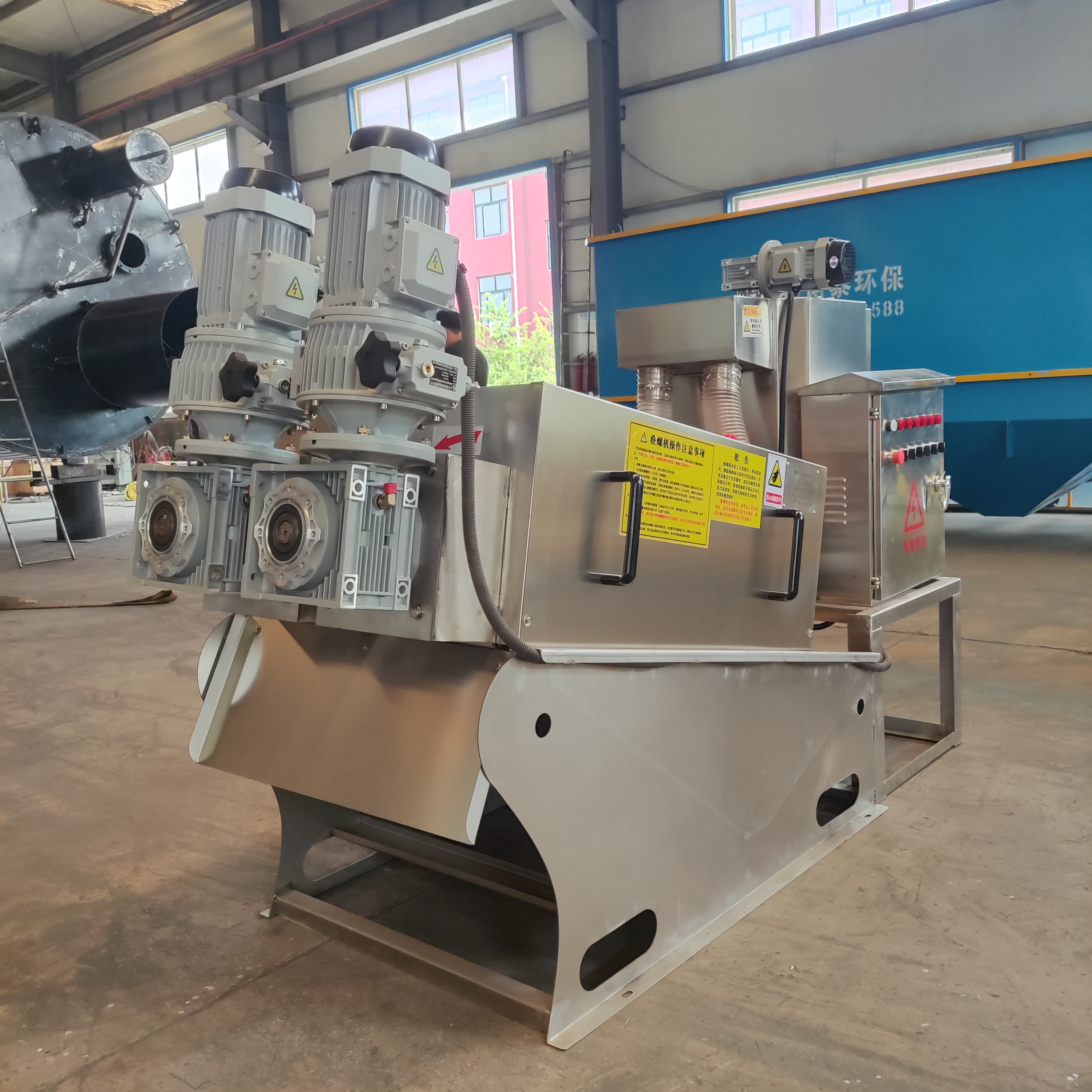
The stacked screw sludge dewatering machine is a new type of solid-liquid separation equipment based on spiral extrusion and laminated filtration technology. With its advantages of high efficiency dewatering, energy saving and environmental protection, and stable operation, it has been widely used in municipal sewage, industrial wastewater, and food processing.
1、 Core principles and structure
(1)The stacked screw sludge dewatering machine pushes the sludge through the rotation of the screw shaft, and combines the relative motion of the fixed ring and the moving ring to achieve solid-liquid separation. The working process can be divided into three stages:
(2)Concentration stage: After entering the equipment, the sludge is initially dehydrated under the action of gravity, and the water is filtered out through the gaps between the rings, increasing the sludge concentration.
(3)Dehydration stage: The pitch of the spiral shaft gradually decreases, the gap between the rings decreases, and the sludge is squeezed and dehydrated under the action of the back pressure plate.
(4)Self cleaning stage: The moving ring rotates with the spiral shaft to automatically clean the filter seam, prevent blockage, and ensure long-term stable operation of the equipment.
2、 Technical features
(1)Efficient dewatering: By using spiral extrusion and laminated filtration technology, the moisture content of the dewatered sludge cake can be reduced to 60% -80%, and some equipment can even lower it, significantly reducing the volume of sludge.
(2)Energy saving and environmental protection: No need to add coagulants (some special sludge requires a small amount of addition), reducing chemical consumption and secondary pollution; The power consumption is only 5% of that of a centrifuge, and the water-saving effect is significant.
(3)Stable operation: Reasonable structural design, low vibration and noise, minimal component wear, and long service life; The self-cleaning function reduces maintenance costs and has a low failure rate.
Easy to operate: With a high degree of automation, it supports remote monitoring and automatic control. Operators only need to start, stop, and adjust through the control panel.
3、 Application scenarios
(1)Municipal sewage treatment: Efficiently treat biochemical sludge, reduce moisture content, and facilitate transportation and disposal.
(2)Industrial wastewater treatment: suitable for industries such as printing and dyeing, pharmaceuticals, petrochemicals, etc., to treat oily and highly viscous sludge and reduce environmental pollution.
(3)Food processing: Processing organic sludge such as slaughterhouse blood, fruit juice and fruit residue, fully enclosed design to avoid leakage, in compliance with hygiene standards.
(4)Emergency treatment: put into use quickly in case of rainstorm or facility failure to avoid sludge overflow.
4、 Advantages and disadvantages analysis
Advantages:
(1)Wide applicability: It can handle low to high concentration sludge without the need for a concentration tank.
(2)Small footprint: Compact design, easy to install and maintain.
(3)Low operating costs: The power consumption, water consumption, and chemical consumption are all lower than traditional equipment.
(4)High stability: The self-cleaning function reduces the risk of blockage and ensures continuous operation.
Disadvantages:
(1)Limited processing capacity: The processing capacity of a single machine is usually between 400-800kg/h (dry weight), and large-scale projects require multiple machines to be connected in parallel.
(2)Sensitive to sludge properties: Sludge containing hard particles such as sand and stones is prone to wear and tear on the dynamic and static rings and spiral shafts.
(3)Fluctuations in moisture content of sludge: Some sludge may have a moisture content higher than 80% after dewatering, which needs to be combined with subsequent treatment.
5、 Conclusion and Suggestions
The stacked screw sludge dewatering machine has significant advantages in small and medium-sized sludge treatment projects due to its high efficiency, energy saving, and stability. For large-scale projects, processing capabilities can be improved by connecting multiple units in parallel or combining them with other devices. In addition, for sludge containing hard particles, pre-treatment is recommended to reduce equipment wear and tear. In the future, with the advancement of technology and the improvement of industry standards, the stacked screw sludge dewatering machine will play an important role in more fields, helping environmental protection and sustainable development.
PREV: Central transmission mud scraper
NEXT: No more